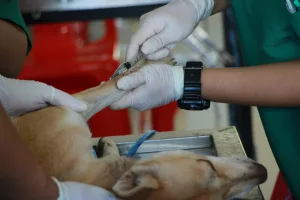Dogs’ remarkable olfactory capabilities far surpass human sensory experiences, offering them a nuanced and complex perception of the world that is primarily scent-driven. With around 300 million olfactory receptors, dogs possess an extraordinary ability to detect and differentiate an immense range of scents, transforming every sniff into a detailed story about their environment. Canine Olfaction When dogs inhale, they don’t just smell; they analyze. The air they draw in splits between their olfactory and respiratory passages, enabling them to simultaneously breathe and assess scents. This bifurcation allows dogs to store scents in their olfactory chamber, providing them with the time and biological resources to identify and remember a vast array of odors. Their ability to detect specific scents is further enhanced by their moist noses, which capture and dissolve scent molecules for better processing.
The Science Behind the Sniff
To appreciate the depth of a dog’s olfactory powers, consider the anatomy of their nose. Unlike humans, dogs have a specialized organ that separates the functions of breathing and smelling. This means that while we might catch a scent in passing, dogs can dedicate their full attention to analyzing smells. The olfactory bulb in a dog’s brain is proportionally 40 times larger than that of a human, emphasizing the importance of smell in their daily lives.
The Anatomy of a Dog’s Nose
A dog’s nose is a marvel of biological engineering. The interior is lined with a complex series of folds called turbinates, which are covered in olfactory receptors. This intricate system maximizes the surface area available for scent detection. Furthermore, dogs possess a unique feature called the vomeronasal organ, which allows them to detect pheromones, adding another layer to their sensory capabilities.
Practical Example: Dogs in Search and Rescue
A real-world illustration of this olfactory prowess is in search and rescue operations. Dogs trained for these missions can track the faintest of human scents over vast distances and challenging terrains. For instance, a trained bloodhound can follow a week-old trail over several miles, making them invaluable in locating lost individuals. Bloodhounds have been known to succeed in tracking missions that even advanced technology struggles with, showcasing the unparalleled efficiency of canine olfaction.
The Training Process for Search and Rescue
Training a search and rescue dog involves simulating real-world scenarios where the dog must rely solely on scent. Trainers use articles of clothing or personal items to familiarize the dog with a specific scent. Over time, dogs learn to ignore distractions and focus on the target scent, a skill that requires patience and persistence.
A Window to the World
Dogs’ sniffing behavior is their primary mode of exploration and understanding of their surroundings. The vomeronasal organ, or Jacobson’s organ, plays a crucial role in this exploratory behavior, particularly in detecting pheromones. This organ provides dogs with a direct channel to the emotional and physiological states of other beings, allowing them to pick up on stress, fear, excitement, and reproductive status, which are essential cues in the animal kingdom.
Deciphering the Invisible
Imagine walking into a room and instantly being able to tell who was there, what they ate, and even how they felt. This is the reality for dogs, whose noses provide insights into the invisible world. For example, a dog might approach a new dog and, with a few sniffs, understand its mood and intentions, which helps in navigating social interactions.
Practical Tips for Dog Owners
To harness this natural curiosity, dog owners can introduce scent-based games. Hide treats around the house or yard and encourage your dog to find them. This not only satisfies their sniffing instincts but also provides mental stimulation. Additionally, using different scents such as lavender or peppermint can introduce variety and challenge your dog’s olfactory senses further.
Establishing Spatial Boundaries
Territorial marking is another pivotal aspect of canine behavior, underpinned by their acute sense of smell. Dogs’ scent glands, located in their paw pads, anal area, and within their urine, excrete unique chemical markers that convey information about their identity and territorial claims. This olfactory signaling is not merely about possession but serves as a complex communication network with other animals, delineating boundaries, signaling availability for mating, and establishing social hierarchies.
The Role of Scent in Social Order
Dogs navigate their social world largely through scent. When a dog urinates on a fire hydrant or a tree, it’s not just marking territory—it’s leaving a message. Other dogs can read these messages to understand who’s in the neighborhood and their status within the social hierarchy. For instance, a higher-ranking dog may choose to urinate over the scent mark of a lower-ranking dog, reinforcing its dominance.
Avoiding Common Mistakes
As a dog owner, it’s important to allow your pet time to sniff during walks. Rushing them through this process can prevent them from gathering important social information. Instead, give your dog opportunities to explore their environment fully. Consider using a longer leash in safe areas to give your dog more freedom to investigate.
Mental Enrichment and Well-being
For dogs, sniffing is not only a necessity but also a source of joy and mental stimulation. The act of sniffing can be likened to a continuous discovery process, where each scent provides a new piece of information or a puzzle to solve. This sensory engagement is crucial for their mental health, preventing boredom and stimulating cognitive functions. The mental enrichment derived from sniffing is comparable to humans engaging in challenging and engaging activities, underscoring the importance of allowing dogs to explore their world through scent.
The Cognitive Benefits of Sniffing
Sniffing serves as a mental workout for dogs. Studies have shown that dogs that engage in regular sniffing activities exhibit lower stress levels and improved overall behavior. This is because sniffing activates parts of the brain associated with learning and memory, much like how humans benefit from puzzles and brain games. By engaging in sniffing activities, dogs can improve their problem-solving skills and adaptability.
Engaging Activities for Mental Stimulation
Consider organizing a “scent trail” in your backyard, where you drag a treat along the ground and let your dog find it. This mimics the tracking activities dogs would perform in the wild and provides both physical and mental exercise. Another fun activity is a “find the treat” game, where you hide treats under cups and encourage your dog to find them using their nose.
Implications for Dog Owners and Trainers
Understanding the significance of sniffing in dogs’ lives has practical implications for their care and training. Encouraging sniffing behavior through scent games, tracking activities, or simply allowing them to explore scents during walks can greatly enhance their quality of life. It’s a recognition of their inherent needs and a step toward providing a more enriching and satisfying environment for our canine companions.
Training Techniques That Incorporate Sniffing
Training sessions can be made more effective by incorporating scent-related tasks. For example, teaching your dog to find objects based on scent can be both rewarding and stimulating. Start with familiar objects and gradually increase the complexity to keep your dog engaged. Incorporating scent work into obedience training can also improve your dog’s focus and responsiveness.
Building a Stronger Bond
Allowing dogs to indulge their sense of smell fosters a deeper connection between pet and owner. When you take the time to understand and cater to their natural behaviors, you build trust and strengthen your relationship. Engaging in activities like scent walks—where you let your dog lead the way based on their nose—can provide insights into their interests and preferences.
Case Study: Therapy Dogs
Consider therapy dogs that visit hospitals and care facilities. These dogs are trained to use their noses to detect changes in human emotions and health conditions, providing comfort and alerting caregivers to potential issues. Their ability to sense subtle shifts in a person’s condition exemplifies the profound impact of their olfactory senses. Therapy dogs often form deep connections with the individuals they help, offering both emotional support and practical assistance.
The Future of Canine Olfaction
The potential applications of a dog’s sense of smell are continually expanding. Researchers are exploring how dogs can be trained to detect diseases such as cancer and diabetes, potentially revolutionizing early diagnosis methods. Dogs are also being used in conservation efforts to track endangered species and detect invasive plants, showcasing their versatility and invaluable contribution to various fields.
Recognizing and nurturing this aspect of canine behavior can significantly enhance their well-being and deepen the bond between dogs and their human counterparts. Allowing your dog to sniff freely, providing scent-based activities, and understanding their olfactory needs can transform your relationship, offering mutual benefits for both you and your furry friend.
By embracing and encouraging your dog’s natural sniffing instincts, you not only cater to their fundamental needs but also enrich their life with purpose and joy. So next time you’re out on a walk, pause and let your dog lead the way with their nose; you might just discover a whole new world together.




